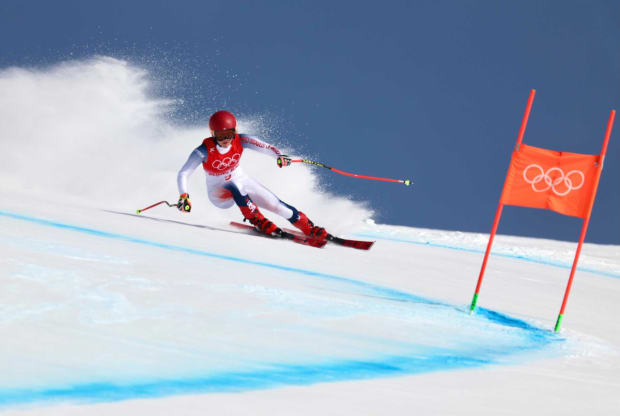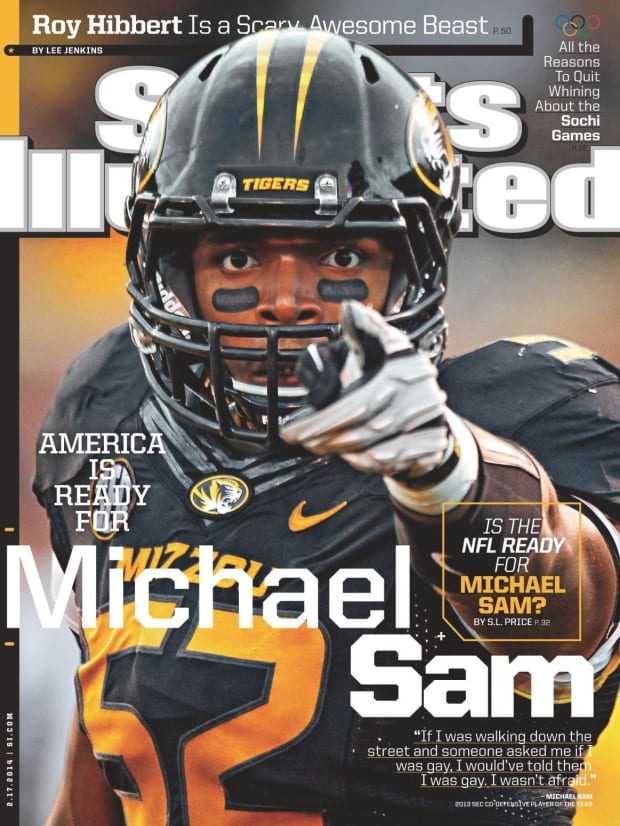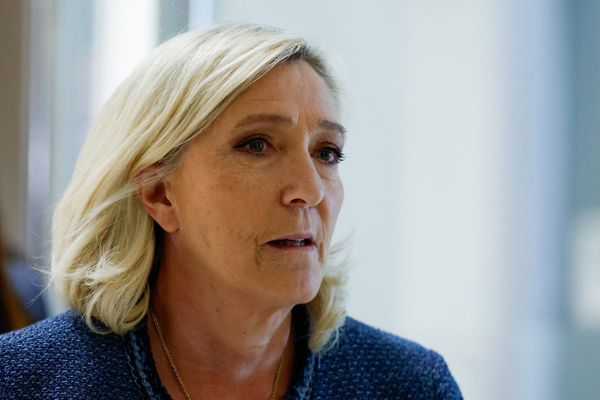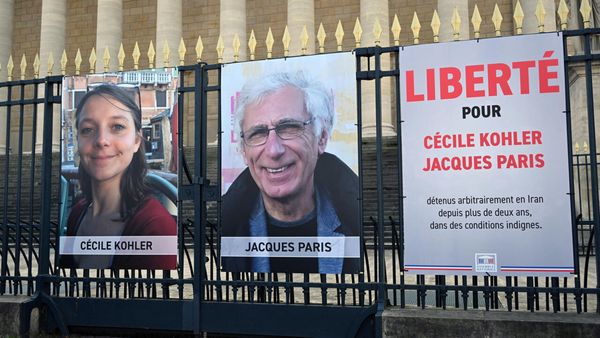Good morning, I’m Dan Gartland. If anyone wants to pay me eight figures to shoot a 110, you know how to get in touch with me.
If you're reading this on SI.com, you can sign up to get this free newsletter in your inbox each weekday at SI.com/newsletters.
Follow the money

Erick W. Rasco/Sports Illustrated
The biggest story in men’s golf right now is the emergence of a potential challenger to the PGA Tour. Rumors of a rival tour have been simmering for years now, but things have really picked up steam in recent weeks. Talk of a breakaway tour has been dominating the Genesis Invitational this week at Riviera.
It’s called the SGL, for Super Golf League, but the “S” might as well stand for Saudi. The Middle Eastern kingdom is funding the effort through its Public Investment Fund, a government-run wealth fund. The PIF is the primary investor in a company called LIV Golf Investments, which in October announced golf great Greg Norman as its CEO. LIV has pledged to pump $200 million into the Asian Tour but the SGL is the bigger story.
What it is: There are no concrete plans, but rumored features of the new tour include several things that are appealing to top players.
- Money: The Saudis have tons of money to throw at players to entice them to join. If you believe the The Daily Mail, they’ve offered Bryson DeChambeau £100 million ($135 million) to sign up. DeChambeau has denied receiving that offer. Other players have reportedly been offered in the $30 million to $50 million range.
- Guaranteed money: Rumors suggest that the bulk of the tournaments would feature smaller fields playing 54 holes with no cuts. (The name of LIV Golf Investments includes the Roman numeral for 54.) That means players would get paid prize money if they have a lousy weekend.
- Different competition formats: Again, details are scarce, but there has been talk of team events (including mixed teams of men and women) in addition to traditional stroke-play tournaments.
Who’s involved: Tour pro Kramer Hickok said during a podcast appearance this week that he’s heard 17 players have signed up to participate. Who they are is of course a mystery, but the breakaway tour has reportedly made offers to some very big names in the golf world, including Phil Mickelson, Bryson DeChambeau and Dustin Johnson. Jon Rahm and Rory McIlroy are among those who oppose the idea.
It’s a very confusing story. Most of what we know comes from reading the tea leaves of gossip among PGA players. I was only vaguely aware of the situation before this week, so I decided to ask an expert to help explain what’s going on: Bob Harig from our golf partners at The Morning Read. Here’s what he had to say (my questions in bold):
This wouldn’t have any momentum if the PGA Tour players didn’t have issues with their current situation. What are their main issues with the status quo?
There is one main issue: a lack of guaranteed money for the top players as it relates to their value to the PGA Tour. All of them agree they are highly compensated via purses and FedEx Cup bonus money, but it’s all based on performance. If you are injured or have a bad year, you get nothing. While there is a charm to that aspect of golf, it doesn’t work that way in any other sport.
Aside from the money, what’s the main appeal of the new tour for players?
The money, especially for the top players, is foremost. The sums being thrown around are massive. Aside from that, it’s a shorter schedule: 54 hole events instead of 72 holes. No cuts, which means guaranteed pay each week. A team format that also has a purse and adds some other intrigue. Team “owners’’ who would pick the other three players on their team.
I’ve read that the prizes for social media engagement offered through the Player Impact Program are one of the PGA’s main efforts to retain players considering a jump to the Saudi tour. Do you think that will be sufficient? What else can the PGA do to keep players from making the leap?
The number was $40 million in 2021, will go to $50 million this year and is expected to go to $70 million by 2025. But it’s only for 10 guys. It’s nice, but it misses the point. While that is not tied directly to on-course performance, it still is not guaranteed and is still a contest that is measured. The best thing the Tour can do to push back is to have some system where players are paid a certain amount regardless of performance. That’s tricky. It could be tied to the number of events, where they are in the world ranking, tournaments won. But that is ultimately what this is about.
Are there any innovations (such as new formats) that the PGA might borrow from the new tour?
The team idea is interesting, but it’s not feasible on a weekly basis. And yet, to really make it work, it has to be incorporated into stroke-play events that count on the schedule. Another idea that has long been discussed is either a mixed-team event or a mixed event with men and women competing on the same venue for different purses. Having another match play event would not be a bad idea, nor would some sort of quota or Stableford event to break up the glut of 72-hole stroke-play events.
I’ve thought that the PGA could dissuade players and courses from joining the new tour by threatening to ban them from future PGA events, but is that realistic? Could that backfire for the PGA?
This is where the lawyers potentially get involved. The Tour has membership rules that require you to play a minimum of 15 events. As long as that is fulfilled, it’s hard to see how someone could be banned for joining another league. And if a player elects to leave and come back, if he fulfills the exemption criteria (i.e., someone who has won a major championship, for example, and has earned a multiple-year exemption), it again seems difficult to keep them from playing.
Saudi Arabia’s motivations remain unclear to me. This seems like a classic example of “sportswashing” but is there any indication of how the country might hope to use golf to bolster its image abroad?
A cynic would suggest that this is all about sportswashing. And they have plenty of facts and figures to back it up. But the Saudi PIF has money in entities all around the world, including U.S. companies such as Disney and Uber. While they are undoubtedly trying to improve their image, there is the potential for tourism, especially golf tourism, that is in play, plus the hope of foreign investment in the country. Safe to say, the answer is far more complicated than a few sentences can provide.
The best of Sports Illustrated
Stephanie Apstein argues that the age minimum for Olympic figure skating, not just to avoid situations like Kamila Valieva’s but to protect athletes:
“The incentives here are backward. Not quite two years after Alina Zagitova won Olympic gold in PyeongChang for Russia at age 15, she was already watching younger girls surpass her as her body changed. She told reporters that she needed ‘to lose some weight’ so that she could do quads and keep pace. Those jumps also strain young athletes’ bones as they are growing; shortly after that interview, Zagitova sustained a hip injury and took an indefinite break from competition.”

Simon Bruty/Sports Illustrated.
Michael Rosenberg was at Mikaela Shiffrin’s final individual event in Beijing, where she one again failed to medal. … Kevin Sweeney has narrowed down the men’s hoops national title winner to one of these eight teams. … Liverpool’s 2–0 Champions League victory over Inter Milan showed that it is a team that can win in multiple ways, Jonathan Wilson writes. … Justin Barrasso has a scoop related to some major news in the world of pro wrestling.
Around the sports world
Adam Silver criticized New York City’s vaccine mandate and, interestingly, the mayor said he thought the rule was “unfair.” … The Cowboys paid $2.4 million to settle a voyeurism complaint against an executive accused of photographing cheerleaders while they changed. … Zion Williamson might need another surgery on the injured foot that has kept him out all year. … Matt Harvey could be handed a 60-game suspension for providing opioids to Tyler Skaggs. … Anthony Davis went down with an ankle injury, but X-rays were reportedly negative. … Aaron Rodgers and Shailene Woodley have reportedly called off their engagement.
The top 5…
… most noteworthy games from last night:
5. Rutgers men upset No. 12 Illinois, 70–59
4. No. 14 Texas women crush No. 6 Iowa State, 73–48
3. No. 11 Texas Tech men beat defending champion No. 7 Baylor for the second time this year
2. Rookie Cam Thomas scores 21 points off the bench (16 in the fourth quarter) as the Nets come back from 28 down to beat the Knicks at MSG
1. Team USA falls to Canada in the women’s hockey gold medal game
SIQ
Today is Michael Jordan’s birthday, so there’s no better time to ask an MJ trivia question. What jersey number did he wear for most of his career? No, just kidding. Everyone knows he made No. 23 the most famous jersey in sports. Obviously, the Bulls retired his number after his iconic career, but so did another NBA team. Which one was it?
Check tomorrow's newsletter for the answer.
Yesterday’s SIQ: What was the main issue in the labor battle that led to the 2004–05 NHL lockout?
Answer: the lack of a salary cap. When the CBA expired in September 2004, the NHL was the only one of the four major men’s North American leagues without a salary cap or luxury tax system. This had long been a major issue in the ‘94–’95 lockout that caused that season to be reduced to just 48 games.
The earlier lockout led to the creation of a rookie salary cap, but owners wanted a leaguewide cap when they locked the players out again 10 years later. A league-commissioned report found that teams spent 76% of revenue on player salaries before the lockout. A later Forbes report found that the number was 66%. It’s shocking that the NHL’s report found the situation to be more dire for the owners, but either number was still significantly higher than the share of revenue distributed to players in other leagues.
Management succeeded in getting the players to agree to a cap, but that didn’t solve all the problems between the league and the union. When that CBA expired in 2012, it led to—you guessed it—another lockout, this time because the owners wanted the players to receive a much smaller share of revenues. That lockout led to another 48-game season. The CBA signed after that labor battle was supposed to expire after this season, but in ’20, both sides agreed to extend it through the end of the ’25–26 season.
From the Vault: Feb. 17, 2014

S.L. Price’s story on Michael Sam’s coming out and the cover text (“America is ready for Michael Sam. Is the NFL ready for Michael Sam?”) correctly identify the divide between the country and the league. By 2014, America had made great (if incomplete) strides with regard to LGBTQ rights, but sports lagged well behind. NBA player Jason Collins had come out the year before and signed with the Nets nine days after this issue hit newsstands. (He played sparingly in 22 games over the course of the rest of the season, becoming the first openly gay man in one of the big four North American leagues.) Robbie Rogers had signed with the LA Galaxy in ’13 and stood alone as the only openly gay male pro athlete in U.S. team sports.
But the spotlight is brighter on the NFL, and particularly on the NFL draft. Sam’s draft stock became a flashpoint, in part because of how the league would or wouldn’t welcome him. Price’s story mentions how college prospects are often asked by teams in predraft interviews if they have a girlfriend. It also includes a quote from former 49ers cornerback Chris Culliver, who said at Super Bowl Media Day in 2013 that any gay players on his team “gotta get up out of here.”
Comments like that—and similarly hostile reactions from Adrian Peterson and Jonathan Vilma—are certainly worthy of attention, but it’s also worth noting that Sam’s Missouri teammates were largely accepting of him when he came out before the start of the 2013 season.
What stands out most to me is how big a story Sam’s coming out was in contrast to Carl Nassib, who last year became the NFL’s first openly gay active player. Maybe my memory is a little fuzzy almost a decade later, but I feel like Sam was under intense scrutiny for months (remember the firestorm after he kissed his boyfriend when he got drafted?), whereas Nassib’s announcement made headlines but wasn’t a season-long narrative. Maybe that’s because Nassib had the advantage of already being an established NFL player or because the country is more accepting of LGBTQ people now. Or maybe it’s because Sam was brave enough to put himself out there in 2014 and get people thinking about the possibility of a gay football player, paving the way for Nassib and others.
Check out more of SI's archives and historic images at vault.si.com.







